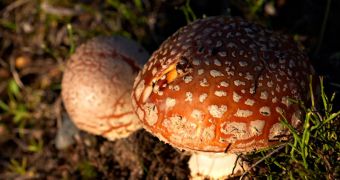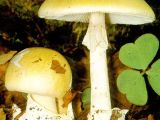Without counting with the microscopic fungi, there are 3,800 species of mushrooms in Europe alone. 250 species are toxic but very few can kill: about 12 species. The same mushroom species can have various effects, depending on its age, consumed amount and the health state of the consumer.
In France, three mushrooms are the main killers, making 98 % of the deadly cases: the death cap (Amanita phalloides), the fool's mushroom (Amanita verna) and the destroying angel (Amanita virosa). 96 % of the deaths are caused by the death cap alone. This mushroom is appealing, without warning colors.
The death cap contains two types of toxins: phallotoxins and amatoxins. Of the amatoxins, the alpha-amanitin is extremely powerful, attacking different human organs, especially the cells of the liver and kidney. Just 20 grams of death cap are enough to kill a 70 kg (150 pounds) man.
Victims present the phalloidian syndrome between 6 and 24 hours after eating the mushroom. Then, a less or more severe hepatitis installs, which can end with the total destruction of the cells of the liver and, consequently, death.
The fool's webcap (Cortinarius orellanus) contains a deadly poison called orellanine.
Lethal webcap (C. rubellus) and Lepiota helviola contain toxins similar to those of Amanita. But these mushrooms cause weak poisonings, as the webcaps are rare, and the Lepiota mushrooms are too small.
The panther cap (Amanita pantherina) is known to cause gut issues and delirium episodes. Fly agaric (Amanita muscaria) was used by the medieval sorcerers to bewitch their victims.
Unlike other boletuses, the Devil's boletus (Boletus satanas) is extremely toxic, causing violent vomiting.
Don't believe that mushrooms consumed by slugs are non-toxic; in fact, slugs adore the death cap! And not all the toxic mushrooms are considered bad by everybody. The "magic mushrooms" induce psychotic effects due to the alkaloid psilocybin.
Psilocybin occurs in high levels in some species of Psilocybe and Panaeolus, and in lower levels in Conocybe, Gymnopilus and Inocybe. Psilocybe, Panaeolus, Conocybe grow in varied habitats, from dung to humus. Inocybe are mycorrhizal (from symbiosis with the trees' roots) while Gymnopilus grow on wood. The total potency varies greatly between species and even between specimens of one species in the same batch. Younger mushrooms contain relatively more alkaloids and have a milder taste than larger, mature mushrooms.
Many types of psilocybin mushrooms turn blue when handled or damaged, but this is not a precise method of determining a mushroom's toxicity. Psilocybin is rapidly turned to psilocin by the body, similar to serotonin (the "happiness hormone"). The psilocybin is mildly toxic, 1.5 times more than the caffeine.
The psilocybin content of mushrooms depends on species, growth and drying conditions, mushroom size, and is on average roughly 5mg/g of dried mushroom, or 1mg/2g of fresh mushroom. Psilocybin is absorbed in the mouth and stomach and its effects start in 10-60 minutes after ingestion, persisting 2-6 hours depending on dose, species and individual metabolism. A standard dose is from 10-50mg Psilocybin, approximately 1-5g dried mushroom or 10-50g wet mushrooms.
The effects of psilocybin are often pleasant, even ecstatic, including a deep sense of connection to others, confusion, hilarity and a general feeling of connection to nature and the universe.
Difficult things may occur when the mushrooms are taken in an improper environment, by an inexperienced person, or in a high dose. At low doses, hallucinatory effects occur, including walls that seem to breathe, a vivid enhancement of colors and the animation of organic shapes. At higher doses, experiences tend to be less social and boosting even more intense spiritual ones.
Mental and physical tolerance to psilocybin builds and dissipates quickly.
Taking psilocybin more than three or four times a week (especially two days in a row) can have diminished effects. Tolerance dissipates after a few days, so frequent users often keep doses spaced five to seven days apart to avoid the effect. Still, the consumption of psilocybin may cause Hallucinogen Persisting Perception Disorder (HPPD).
Psilocybin can also induce small physical effects, like appetite loss. Overdoses (above 2? grams) induce feelings of coldness, numbness of the mouth and adjacent features, nausea, weakness in the limbs (making locomotion difficult), excessive yawning which usually occurs during the come-up, swollen features, pupil dilation and stiffness in points of the body and consumers can take weird positions as they lose ability to accurately assess the flow of time and their level of fatigue.
In most countries, the possession and use of psilocybin mushrooms is prohibited under almost all circumstances and often carry severe legal penalties.
Psilocybin mushrooms are easy to cultivate or gather from the wild species. Some psilocybin mushrooms have a bitter taste that prevents people from their consumption (like the Gymnopilus luteofolius from the Pacific Northwest of North America).

 14 DAY TRIAL //
14 DAY TRIAL // 
